Does your dog cower when the outside world gets loud? You may wonder, can a dog crate be a sanctuary of silence?
Yes, with the right materials and methods, you can soundproof your dog’s crate, creating a calm space for your pet even amidst the loudest noises.
Ready to bring peace to your pup’s personal space? Let’s dive into how to craft a quiet crate for your canine.
Preparing To Soundproof Your Dog Crate
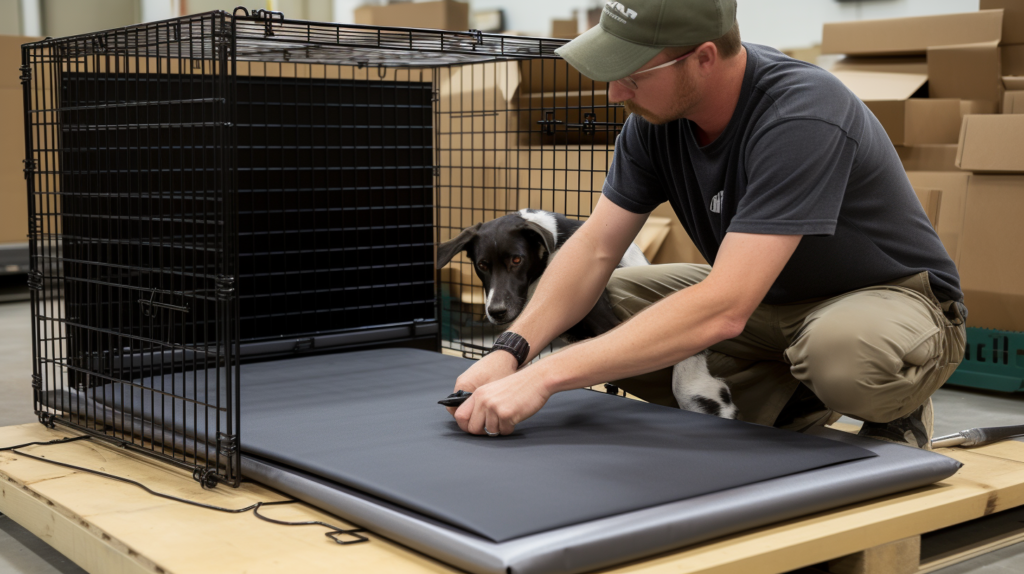
Choosing the right dog crate is a decision that should be approached with consideration for both the size of your dog and the potential noise levels in your environment.
While a metal grill crate is common and offers great ventilation, it does little to dampen the disturbing sounds that can cause anxiety in dogs. Instead, look for a crate with a combination of solid walls and ventilation panels.
These solid areas provide crucial surfaces for attaching sound dampening materials without completely sacrificing air flow.
Once the right crate is selected, the next step is to gather the materials you’ll need for soundproofing. Automotive sound deadening sheets are an excellent choice for this purpose.
These sheets are specifically designed to dampen the noise in cars, which is often similar to the frequencies and volumes that can disturb dogs.
The material is dense, which is perfect for blocking out sound, but also flexible, making it easy to work with and apply to the various surfaces of a dog crate.
Along with the sound deadening sheets, a moisture-proof mat is essential. This mat serves several purposes: it provides an additional layer of sound dampening, it makes the crate more comfortable for your dog, and it ensures easy cleanup in case of accidents.
The mat should be constructed from a non-toxic, durable material that won’t degrade with frequent cleaning or exposure to moisture.
Before you start the installation process, it’s important to have the right tools on hand. A measuring tape will be needed to measure both the crate and the soundproofing materials to ensure a perfect fit.
A utility knife or a pair of heavy-duty scissors will be required to cut the sound deadening material to the correct size. If you’re using self-adhesive sound deadening sheets, you may need a roller to help apply the material evenly and firmly.
Can You Soundproof A Dog Crate?

Yes, soundproofing a dog crate is not only possible, but it’s also a practical solution for pet owners looking to provide their dogs with a sanctuary from the noise of everyday life.
The process involves adding materials that absorb, dampen, or block noise, creating a quieter space inside the crate.
Soundproofing a dog crate is a methodical process that requires careful selection of materials and a step-by-step approach to ensure effectiveness.
By adhering to the guidelines for preparing the crate, choosing the right soundproofing materials, and ensuring proper ventilation, you can create a significantly quieter environment for your dog.
It’s important to note that while you may not be able to block out all noise completely, the eduction in sound levels can be substantial, making a positive difference in your dog’s comfort and stress levels.
Step-By-Step Guide To Soundproofing A Dog Crate
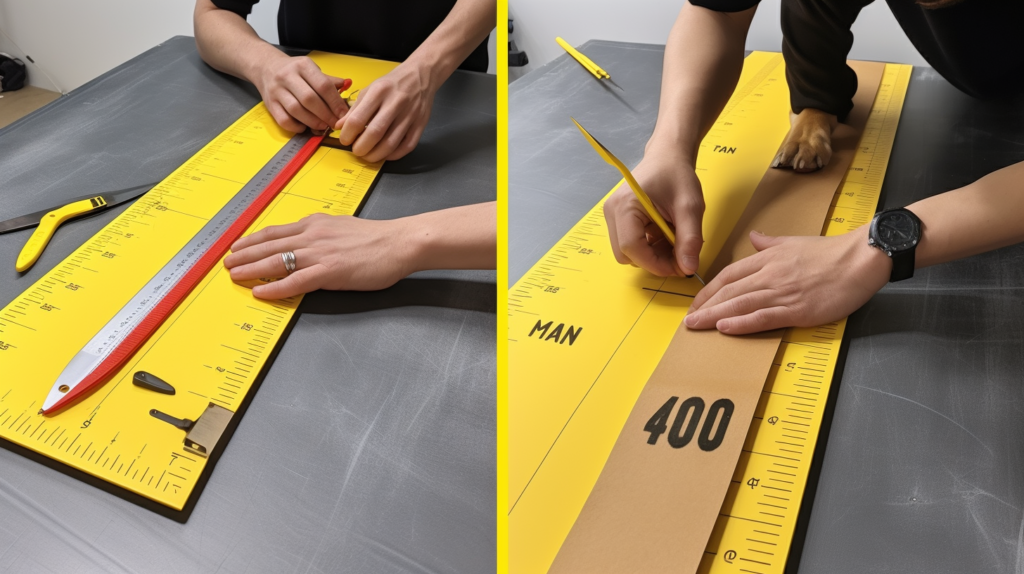
Measuring your dog crate accurately is the first practical step in the soundproofing process. Begin by measuring the length and height of each solid wall panel where you plan to apply the sound deadening sheets.
It’s important to measure twice to ensure accuracy; any gaps left uncovered can significantly undermine the soundproofing effectiveness.
Cutting the sound deadening sheets to size is a task that requires precision. Lay the sheets out on a flat, clean surface and use a straight edge to guide your utility knife or scissors.
If you’re using a roll of material, be mindful to cut in straight, even lines to ensure each piece fits snugly against the crate walls. The goal is to have the sheets fit so perfectly that they look as though they were made for your specific crate.
Applying the sound deadening material to the crate is perhaps the most critical step. If you’re using adhesive-backed sheets, carefully peel the backing off and apply the sheet from one end of the wall to the other, smoothing out any bubbles or wrinkles as you go.
For sheets that aren’t adhesive-backed, you’ll need to apply a pet-safe adhesive. Spread the adhesive evenly on the crate wall, and then press the sheet into place.
It’s important to work quickly but carefully to ensure the adhesive doesn’t dry before the sheet is properly positioned.
Once the sound deadening sheets are securely in place, it’s time to address the crate floor. Place the moisture-proof mat inside, trimming it if necessary to ensure it fits without bunching up.
The mat should lie flat and cover the entire floor. If it curls up at the edges, your dog might chew on it, so it’s important to ensure a flush fit.
How To Enhance Ventilation And Temperature Control Of Soundproofed Crates
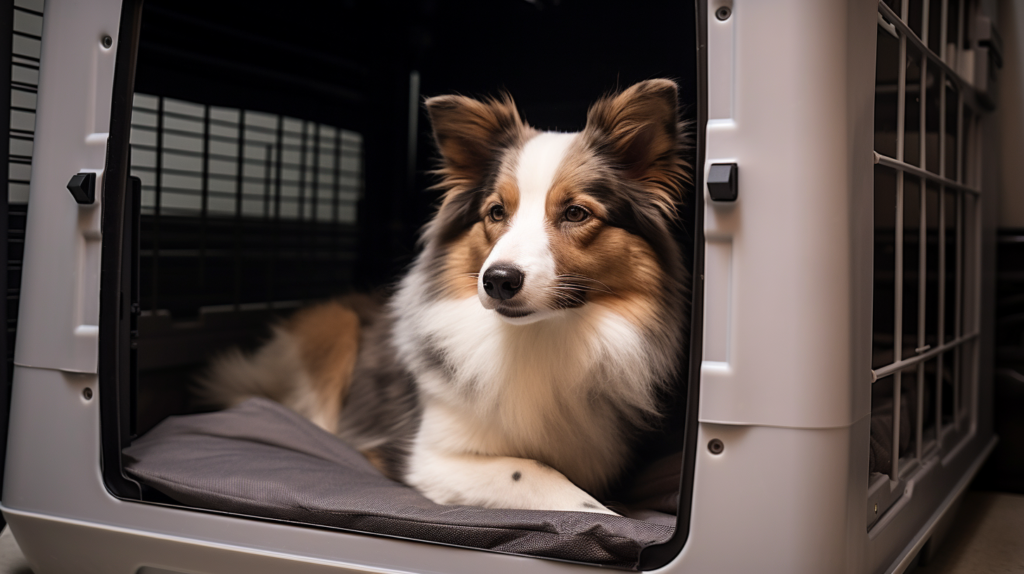
Ensuring adequate ventilation within a soundproofed dog crate is crucial for your pet’s health and comfort. While the sound deadening materials will help reduce noise, they should not restrict the flow of air.
This is where the installation of a small fan can make a significant difference. Choose a fan that is quiet, to not counteract your soundproofing efforts, and ensure it is positioned to circulate air without creating a draft on your dog.
The placement of your soundproofed crate within your home should be strategic. Avoid areas that are prone to high foot traffic or that amplify sounds, like hallways or near doors leading outside.
Instead, find a quiet corner where the crate can be shielded from the majority of household noise. This location should also be temperature controlled.
Avoid placing the crate near windows where direct sunlight can cause the interior to become too warm, especially after applying soundproofing materials.
Temperature control within the crate is also vital. Soundproofing materials, by their nature, can insulate the crate, potentially leading to a warmer interior.
To mitigate this, choose materials that are effective at blocking sound but are not overly thick or dense.
You should also consider the color of the materials; lighter colors will reflect light and heat, whereas darker colors will absorb it, potentially increasing the temperature inside the crate.
Keeping Your Soundproofed Dog Crate Clean And Maintained
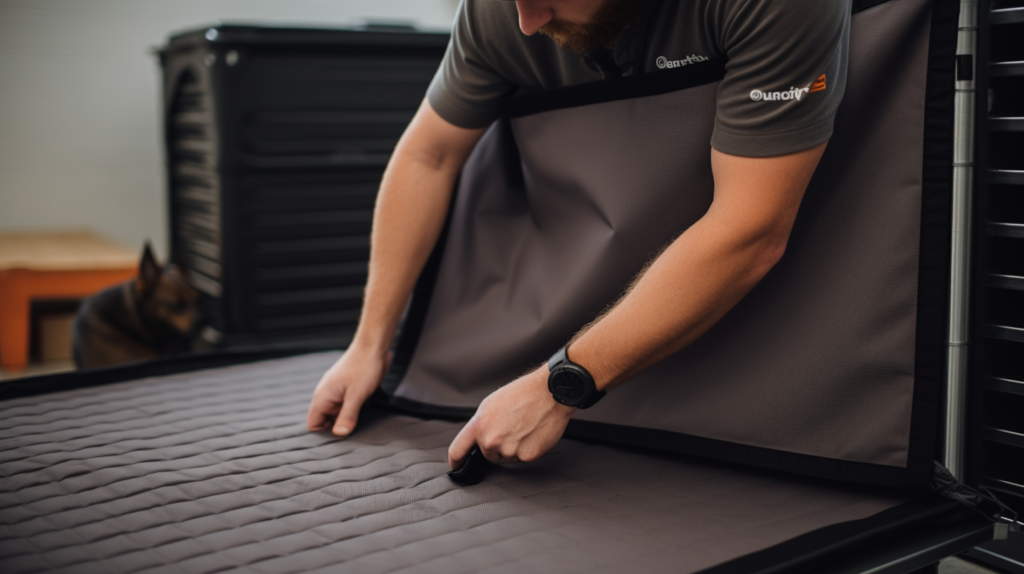
Keeping a soundproofed dog crate clean is just as important as the initial setup. The moisture-proof mat that you’ve chosen for the crate floor will help with this.
It’s designed to be easily removable and washable, which is essential for maintaining a sanitary environment for your dog. Regular cleaning of the mat will prevent the buildup of bacteria and odors.
The soundproofing materials on the walls of the crate will also need to be maintained. These should be made from a material that is easy to wipe down in the event of spills or splashes.
A regular cleaning schedule should be established to ensure that the crate remains a clean and healthy space for your pet.
If any of the soundproofing materials begin to show signs of wear, such as peeling or tearing, they should be replaced promptly to maintain the effectiveness of the soundproofing.
In addition to routine cleanings, a deep clean of the entire crate should be conducted periodically. This involves dismantling the crate if possible, and cleaning each component separately.
The soundproofing materials should be inspected for any areas that may need repair or reinforcement. This is also a good time to wash all of the bedding and inspect the fan for any dust buildup that could impede its function.
Remember To Ensure Proper Installation And Safety
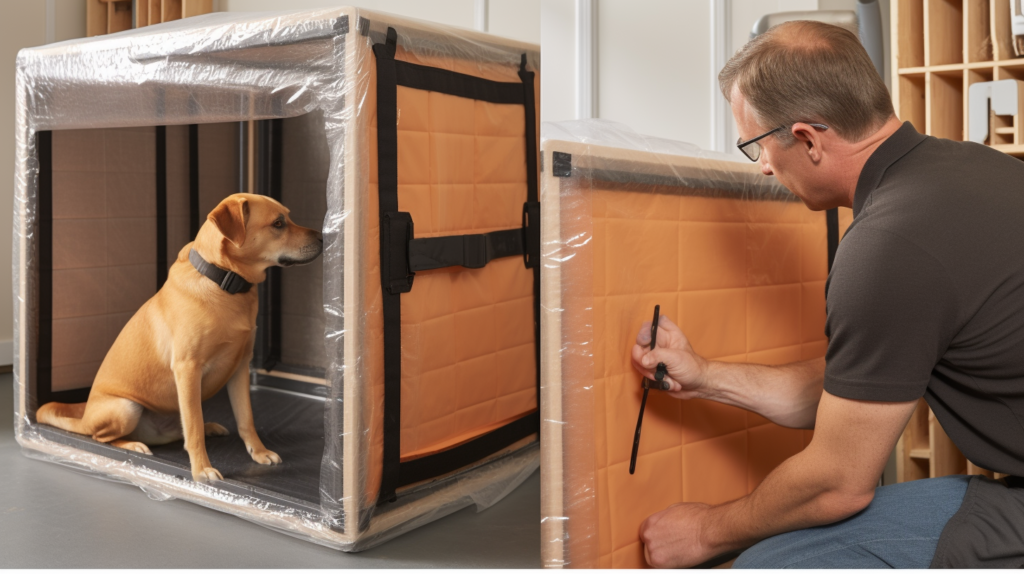
The installation of soundproofing materials in a dog crate is not just about noise reduction; it’s about ensuring the safety and comfort of your pet.
Each soundproofing panel must be inspected thoroughly after installation to guarantee that there are no loose edges or corners that could be chewed or clawed by your dog.
The adhesives used should be strong enough to withstand the curiosity and energy of your pet, but also safe and non-toxic to avoid any risk of poisoning.
When installing soundproofing materials, it’s critical to maintain the structural integrity and function of the crate. Doors must open and close smoothly, locks should secure properly, and the crate should remain a safe haven for your dog to retreat to.
Regular inspections of the crate’s functionality are as important as the initial installation. If any adjustments or repairs are necessary, they should be made promptly to prevent escape or injury.
Add A Soft Bedding Inside The Crate To Help Enhance Calming Atmosphere

The environment within the crate should be a serene sanctuary for your dog, even beyond the reduction of noise. The selection of bedding is crucial; it should be plush enough to provide comfort, yet sturdy enough to resist tearing and withstand frequent washing.
Bedding also serves as an additional layer of sound dampening, so its material can contribute to the overall quietness of the crate.
To enhance the calming atmosphere, consider the use of pheromone diffusers or sprays that can provide a sense of comfort and security for your dog. These products are designed to mimic the natural pheromones that dogs produce, which can help to soothe and calm anxious pets.
When used in conjunction with soundproofing, they can make the crate an even more peaceful environment.
Do Regular Monitor To Observe If Your Dog Likes Its Soundproofed Crate
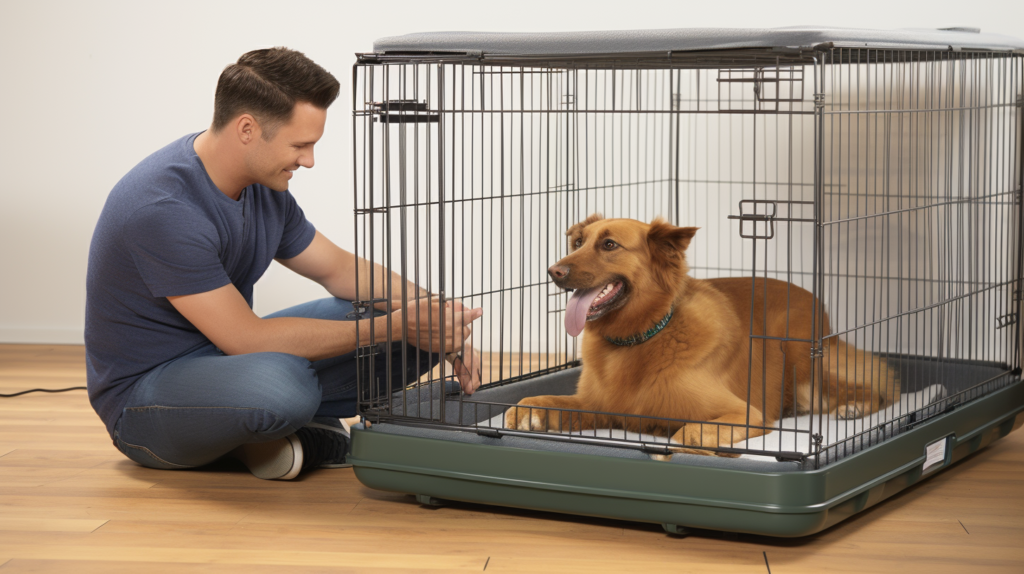
Monitoring your dog’s reaction to the soundproofed crate is essential for ensuring that the modifications are having the desired effect.
Observe your pet’s behavior for any changes that might suggest discomfort or anxiety, such as reluctance to enter the crate or excessive panting. These could be signs that the crate is too warm or that the airflow is insufficient, prompting a reassessment of the soundproofing setup.
Regular health checks are also important, especially in the initial days after soundproofing the crate. Check for any signs of overheating, such as excessive thirst or lethargy.
Make adjustments to the crate’s location, the amount of soundproofing material used, or the airflow to ensure that your dog remains comfortable and healthy.
Adjust Anything Based On Observing Your Dog
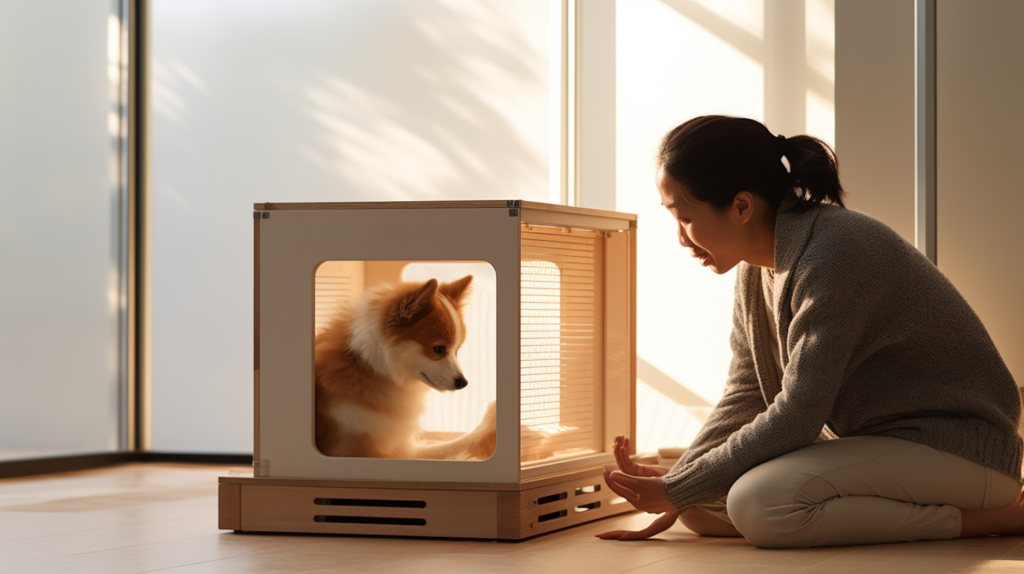
Flexibility is key when maintaining a soundproofed dog crate. Over time, you may find that certain materials wear out or that your dog’s needs change.
Be prepared to make adjustments, whether it’s replacing a section of soundproofing material or adding additional ventilation. The well-being of your pet should always be the primary concern, and the soundproofing setup should evolve to meet those needs.
Ongoing care includes not only regular cleaning and maintenance but also being attentive to your dog’s comfort levels. If the soundproofing materials make the crate too dark or enclosed, your dog may not be as keen to use it.
Experiment with different setups to find the perfect balance between noise reduction and a welcoming environment. Remember that the ultimate goal is to provide a safe, comfortable, and quiet space for your dog to relax in.
Conclusion
The path to a soundproofed dog crate is a testament to the devotion of pet owners. It underscores the reality that a tranquil space for your dog is not just possible, it’s achievable with the right approach and materials.
By investing in soundproofing, you’re ensuring your dog’s environment is as stress-free as possible.
Soundproofing a crate goes beyond noise reduction; it’s about creating a haven that attends to every aspect of your pet’s comfort. Regular maintenance and a willingness to adapt will keep your dog’s haven safe and serene.
In essence, the answer is clear: You can soundproof a dog crate effectively. Armed with these insights, you’re ready to enhance your dog’s quality of life, providing peace and quiet in a world full of clamor.
